Quantitative Evaluation of Imbibition Damage Characteristics of Foaming Agent Solutions in Shale Reservoir
Abstract
:1. Introduction
2. Analysis of the Shale Reservoir Characteristics
2.1. Mineral Composition Characteristics
2.2. Microscopic Pore Throat Characteristics
2.3. Wettability Characteristics
3. Foaming Agent Type and Quantification of Sensitivity to Concentration
3.1. Foaming Agent Type
3.2. Quantitative Evaluation of the Impact of Concentration of the Foaming Agent on Rock Permeability
- (1)
- A grinder and sandpaper were used to polish the core end face, measure the length L and diameter D of shale, dry the shale core column at 100 °C, and then measure the effective porosity φ of shale samples by the gas (helium) expansion method.
- (2)
- The shale core was put into the core holder, the confining pressure was increased to 9 MPa, and the valve was opened to fill in nitrogen with a pressure of 6.8 MPa (1000 psi). After the gas pressure stabilized, the valve was closed, and the outlet valve of the downstream chamber was opened, and then a small amount of gas was released. We then measure the relationship between the upstream chamber pressure pu and downstream chamber pressure pd with pressure, and then calculate the permeability of the core column. During the whole permeability test process, the data acquisition and the corresponding solution processing were all completed by the software of the instrument.
4. Damage Characteristics of Foaming Agent Solution to Shale Reservoir
4.1. Experimental Procedure
- (1)
- After centrifuging the core, we placed the core in an incubator and heated it to 105 °C for 48 h, then removed it and measured the dry weight and size of the core.
- (2)
- Dry core was placed in simulated fracturing fluid and heated to 110 °C (simulated formation temperature) in a constant temperature bath.
- (3)
- In order to conform to the actual situation on site, the core was first placed in a beaker for the imbibition experiment of fracturing fluid. The imbibition experiment was carried out at a constant temperature of 80 °C for 12 h, and then the T2 relaxation time spectrum of the core was measured.
- (4)
- After the above experimental steps were completed, the cores were placed in simulated formation water with different concentrations of foaming agents (0.2%, 0.4%, 0.6%, 0.8%, and 1.0%) to imbibe for 12 h, and the T2 relaxation time spectra of the cores were measured.
- (5)
- After the above experimental steps were completed, the experimental steps (1)–(3) were repeated. The optimal concentration of foam discharge agent solution was imbibed at 110 °C for 12 h, 24 h, 36 h, 48 h, and 72 h, respectively, and then the T2 relaxation time spectrum of the core was measured.
4.2. Results and Discussion
5. Conclusions
- (1)
- The components of the local shale were determined to be quartz, carbonate, and feldspar by a descending content sequence. Clay minerals primarily included illite, chlorite, kaolinite, and illite-smectite interlayer, where illite took up the largest portion. The damage to the shale reservoir was possibly caused by the high content of clays. Nitrogen adsorption tests on multiple cores determined the BET-specific surface areas of 1.81~11.43 m2/g with a mean of 5.22 m2/g. The total pore volume of BJH ranged from 0.0095 to 0.03 mL/g with a mean of 0.0203 mL/g, and an average pore diameter range of 9.79~18.87 nm with a mean of 14.81 nm. The contact angle was between 6.57 and 36.12 degrees. This confirmed the wettability of the shale as primarily hydrophilic. The foaming agent increased the contact angle of fluids and decreased the capillary pressure.
- (2)
- Foaming agents were selected by a primary screening and based on temperature, pressure, salinity, surface tension, and liquid-carrying capacity. We selected the two most suitable agents, i.e., HY-3K and UT-18. They could adapt a temperature of 150 °C, a pressure of 12 MPa, and a salinity of 200,000 mg/L or more.
- (3)
- The shale damage rate was measured to be 26.8–45% from sensitivity tests under different foaming concentrations. The damage rate curves generally showed a V-shape, where the minimum damage was in the concentration range of 0.4–0.5%.
- (4)
- All samples were soaked with slick water and later applied to damage tests with foaming agents. This conformed to the practical fracturing operation. A typical double-peak characteristic of shale was determined in the T2 spectra. The pore dimensions were confirmed to be in a nanometer order.
- (5)
- Measurements of overall damage rate were conducted under different foaming concentrations. A minimum shale damage rate was determined at the concentration range of 0.4–0.6%. The effects of foaming solutions on damage were studied by investigating the damage in spontaneous imbibition, which was influenced by interfacial tension for different pores. An optimal interfacial tension was determined to reach the minimized damage in spontaneous imbibition. Minor pores were the major pore type because their damage rate was consistent with the total damage rate. For medium and macro pores, the damage rates were close to the overall damage rates. An absence in damage was confirmed at some concentration ranges, where permeability acceleration was found.
- (6)
- The damage rate gradually increased as the soaking time increased. Initially, it increased significantly and then remained constant for the residual experimental time. The damage rates remained constant at 72 h, 48 h, and 36 h for macro, medium, and minor pores, respectively. For macro pores, the damage rate gradually increased throughout the experiment.
Author Contributions
Funding
Institutional Review Board Statement
Informed Consent Statement
Data Availability Statement
Conflicts of Interest
References
- Chen, M.Y. Characteristics and Evaluation of Shale Reservoir in Shanxi Formation in Yan’an Area. Master’s Thesis, Xi’an Shiyou University, Xi’an, China, 2020. [Google Scholar]
- Shao, Z.B. Study on the Combination of Low-Harm Surfactants in Shale Reservoir and Its Action Mechanism. Master’s Thesis, Chengdu University of Technology, Chengdu, China, 2016. [Google Scholar]
- Amaefule, J.O.; Ajufo, A.; Peterson, E.; Durst, K. Understanding formation damage processes: An essential ingredient for improved measurement and interpretation of relative permeability data. In Proceedings of the SPE Production Operations Symposium, Oklahoma City, OK, USA, 8–10 March 1987; OnePetro: Richardson, TX, USA, 1987. [Google Scholar]
- Gdanski, R.D.; Weaver, J.D.; Slabaugh, B.F.; Walters, H.G.; Parker, M.A. Fracture face damage–it matters. In Proceedings of the SPE European Formation Damage Conference, Sheveningen, The Netherlands, 25–27 May 2005; OnePetro: Richardson, TX, USA, 2005. [Google Scholar]
- Civan, F. Analyses of processes, mechanisms, and preventive measures of shale-gas reservoir fluid, completion, and formation damage. In Proceedings of the SPE International Symposium and Exhibition on Formation Damage Control, Lafayette, LA, USA, 26–28 February 2014; OnePetro: Richardson, TX, USA, 2014. [Google Scholar]
- Zheng, L.H.; Wei, P.F. Review to shale gas formation damage for 30 years. Oil Drill. Prod. Technol. 2013, 35, 1–16. [Google Scholar]
- Lu, Z.; Li, Q.; Li, J.; Song, F.; Liu, H. Research development on formation damage induced by shale drilling. Chem. Eng. Oil Gas/Shi You Yu Tian Ran Qi Hua Gong 2013, 42, 49–52. [Google Scholar]
- Zhang, F. Study on Low-Damage Fracturing Fluid System of Yanchang Luxiangchang 7 Shale Gas Reservoir. Ph.D. Thesis, China University of Geosciences, Wuhan, China, 2017. [Google Scholar]
- Liu, X.M.; Feng, S.J. Experimental study on permeability change law of shale cores before and after soaking in active water. Contemp. Chem. Eng. 2017, 46, 622–624. [Google Scholar]
- Wang, R.; Wu, X.; Yun, M.A.; Zhang, N. Status-quo of Study on the Methods of Evaluating Formation Damage by Shale Gas Reservoir Working Fluids. Drill. Fluid Complet. Fluid 2019, 36, 672–678. [Google Scholar]
- Wang, R.; Wu, X.M.; Ma, Y.; Bai, H.T. Review of Working Fluid Damage Mechanism for Shale Gas Reservoir. Sci. Technol. Eng. 2020, 20, 867–873. [Google Scholar]
- Yi, M.H.; Jiang, Z.G.; Zeng, J.; Nie, J. Fracturing fluid damage experiment of shale reservoirs in Wufeng-Longmaxi Formation in Southeast Chongqing. West. Prospect. Proj. 2020, 32, 55–58. [Google Scholar]
- Xiong, J.; Chen, S.S.; Liang, L.X.; Xiao, Y.Y.; Chen, L.; Yang, L.P. Infiltration characteristics and influencing factors of Longmaxi Formation shale. J. Guilin Univ. Technol. 2020, 40, 688–694. [Google Scholar]
- Ke, C.Y.; Wei, Y.L.; Zhang, Q.Z.; Zhang, S.L. Research progress of water lock damage and water lock release technology in low permeability gas reservoirs. Appl. Chem. Eng. 2021, 50, 1613–1617. [Google Scholar]
- Xu, F. Considering the spontaneous imbibition characteristics of fracturing fluid in shale gas reservoir under the action of chemical osmotic pressure. Lithol. Reserv. 2021, 33, 145–152. [Google Scholar]
- Xu, D.J.; Zhang, B.H.; Li, Z.H.; Xue, J.S.; Chen, J.F. Study on the law of imbibition damage in the whole process of tight gas fracturing fluid and reservoir. J. Yangtze Univ. (Nat. Sci. Ed.) 2022, 19, 79–85. [Google Scholar]
- Wang, X.P.; Mou, C.; Ge, X.; Chen, X.; Zhou, K.; Wang, Q.; Liang, W. Mineral component characteristics and evaluation of black rock series of Longmaxi Formation in Southern Sichuan and its periphery. Acta Pet. Sin. 2015, 36, 150–162. [Google Scholar]
- Jin, Y.X. Study on the Characteristics of Longmaxi Shale Reservoirs in the Lower Silurian of Southeastern Sichuan Area. Master’s Thesis, School of Geosciences China University of Petroleum (East China), Shandong, China, 2017. [Google Scholar]
- Guan, X.X. Study of the Mechanism and Control Methods of Formation Damage for Longmaxi Shale Formation in Eastern Sichuan. Ph.D. Thesis, Chengdu University of Technology, Chengdu, China, 2016. [Google Scholar]
- Gao, H.; He, M.; Zhao, P.; Dou, L.; Wang, C. Comparison of geological characteristics of Chang 7 shale oil in Ordos Basin and typical shale oil in North America. Pet. Geol. Exp. 2018, 40, 133–140. [Google Scholar]
- Zhang, M.Q.; Zou, C.N.; Guan, P.; Dong, D.Z.; Sun, S.S.; Shi, Z.S.; Li, Z.X.; Feng, Z.Q.; Li, L.M.C.D. Pore throat characteristics of deep shale reservoirs in Sichuan Basin—Taking Longmaxi Formation of Well 201 in Zigong as an example. Nat. Gas Geosci. 2019, 30, 1349–1361. [Google Scholar]
- Liu, Y.X.; Wang, K.L.; Hu, P.Q.; Li, W.M. Discussion on the determination method of mineral components in shale. Nat. Gas Geosci. 2015, 26, 1737–1743. [Google Scholar]
- Lai, F.; Leng, H.; Gong, D. Evaluation of shale brittleness based on mineral compositions and elastic mechanics parameters. Fault-Block Oil Gas Field 2019, 26, 168–171. [Google Scholar]
- Liu, X.J.; Xiong, J.; Liang, L.X.; Luo, C.; Zhang, A.D. Wettability analysis and influence discussion of Longmaxi shale in southern Sichuan. Nat. Gas Geosci. 2014, 25, 1644–1652. [Google Scholar]
- Fan, Q.Y. Effect of wettability and pore structure on adsorption characteristics of shale reservoirs. J. Chongqing Univ. Sci. Technol. (Nat. Sci. Ed.) 2016, 18, 10–13. [Google Scholar]
- Ye, H.; Ning, Z.; Wang, Q.; Cheng, Z.; Huang, L.; Mu, D. Spontaneous imbibition experiment and wettability of shale reservoir. Fault-Block Oil Gas Field 2019, 26, 84–87. [Google Scholar]
- He, J.G.; Kang, Y.L.; You, L.J. Influence of fluid damage on shale reservoir stress sensitivity. Nat. Gas Geosci. 2011, 22, 915–919. (In Chinese) [Google Scholar]
- Huang, W.; Qiu, Z.; Yue, X. Damage mechanism and water-based drilling fluid protection technology for shale gas reservoir. J. China Univ. Pet. (Ed. Nat. Sci.) 2014, 38, 99–105. [Google Scholar]
- Li, X.C.; Yan, X.P.; Kang, Y.L. Investigation of drill-in fluids damage and its impact on wellbore stability in Longmaxi shale reservoir. J. Pet. Sci. Eng. 2017, 159, 702–709. [Google Scholar] [CrossRef]
- Zhang, J.; Nan, X. The analyses on potential damages and the discussions on protection technologies in shale gas reservoir drilling. Petrochem. Ind. Appl. 2015, 34, 1–4. [Google Scholar]
- Jiang, Z.X.; Zhang, W.; Liang, C.; Wang, Y.; Liu, H.; Chen, X. Basic characteristics and evaluation of shale oil reservoirs. Pet. Res. 2016, 1, 149–163. [Google Scholar] [CrossRef]
- Liu, X.W.; Guo, Z.Q.; Liu, C.; Liu, Y.W. Anisotropy rock physics model for the Longmaxi shale gas reservoir, Sichuan Basin, China. Appl. Geophys. 2017, 14, 21–30. [Google Scholar] [CrossRef]
- Yuan, J.H. Promoting Environmental Protection While Boosting Shale Gas Development in China. In SPE Unconventional Resources Conference; Alberta: Edmonton, AB, Canada, 2013. [Google Scholar]
- Son, A.J.; Neal, V.S.; Garvey, C.M. Shale and Salt Stabilizing Drilling Fluid. U.S. Patent No. 4,526,693, 2 July 1985. [Google Scholar]
- Tianshou, M.A.; Chen, P. Study of meso-damage characteristics of shale hydration based on CT scanning technology. Pet. Explor. Dev. 2014, 41, 249–256. [Google Scholar]
- Murphy, R.P.; Frank, O.J., Jr. Minimizing Clay and Shale Damage in A Log-Inject-Log Procedure. U.S. Patent No. 4,281,712, 4 August 1981. [Google Scholar]
- Lauzon, R.V. Colloid science resolves shale, formation-damage problems. Oil Gas J. 1984, 82. Available online: https://www.osti.gov/biblio/6425712 (accessed on 4 August 2022).
- Kang, Y.L.; Chen, Q.; You, L.; Wang, Q.; Yang, B.; Yu, Y. Laboratory investigation of water phase trapping damage in shale gas reservoir—A case of Longmaxi shale in the eastern Sichuan Basin. Pet. Geol. Recovery Effic. 2014, 21, 87–91. [Google Scholar]
- Sun, W.; Zuo, Y.; Wu, Z.; Xu, Y. Experimental study on seepage-damage evolution of shale. China Min. Mag. 2017, 26, 142–145. [Google Scholar]
- Liu, K.; Zakharova, N.; Adeyilola, A.; Zeng, L. Experimental Study on the Pore Shape Damage of Shale Samples during the Crushing Process. Energy Fuels 2021, 35, 2183–2191. [Google Scholar] [CrossRef]
- Dou, L.; Xiao, Y.; Gao, H.; Wang, R.; Liu, C.; Sun, H. The study of enhanced displacement efficiency in tight sandstone from the combination of spontaneous and dynamic imbibition. J. Pet. Sci. Eng. 2021, 199, 103327. [Google Scholar] [CrossRef]
- Dou, L.; Shu, G.; Gao, H.; Bao, J.; Wang, R. Study on the Effect of High-Temperature Heat Treatment on the Microscopic Pore Structure and Mechanical Properties of Tight Sandstone. Geofluids 2021, 2021, 8886186. [Google Scholar] [CrossRef]
- Dou, L.; Yang, M.; Gao, H.; Jiang, D.; Liu, C. Characterization of the Dynamic Imbibition Displacement Mechanism in Tight Sandstone Reservoirs Using the NMR Technique. Geofluids 2020, 2020, 8880545. [Google Scholar] [CrossRef]


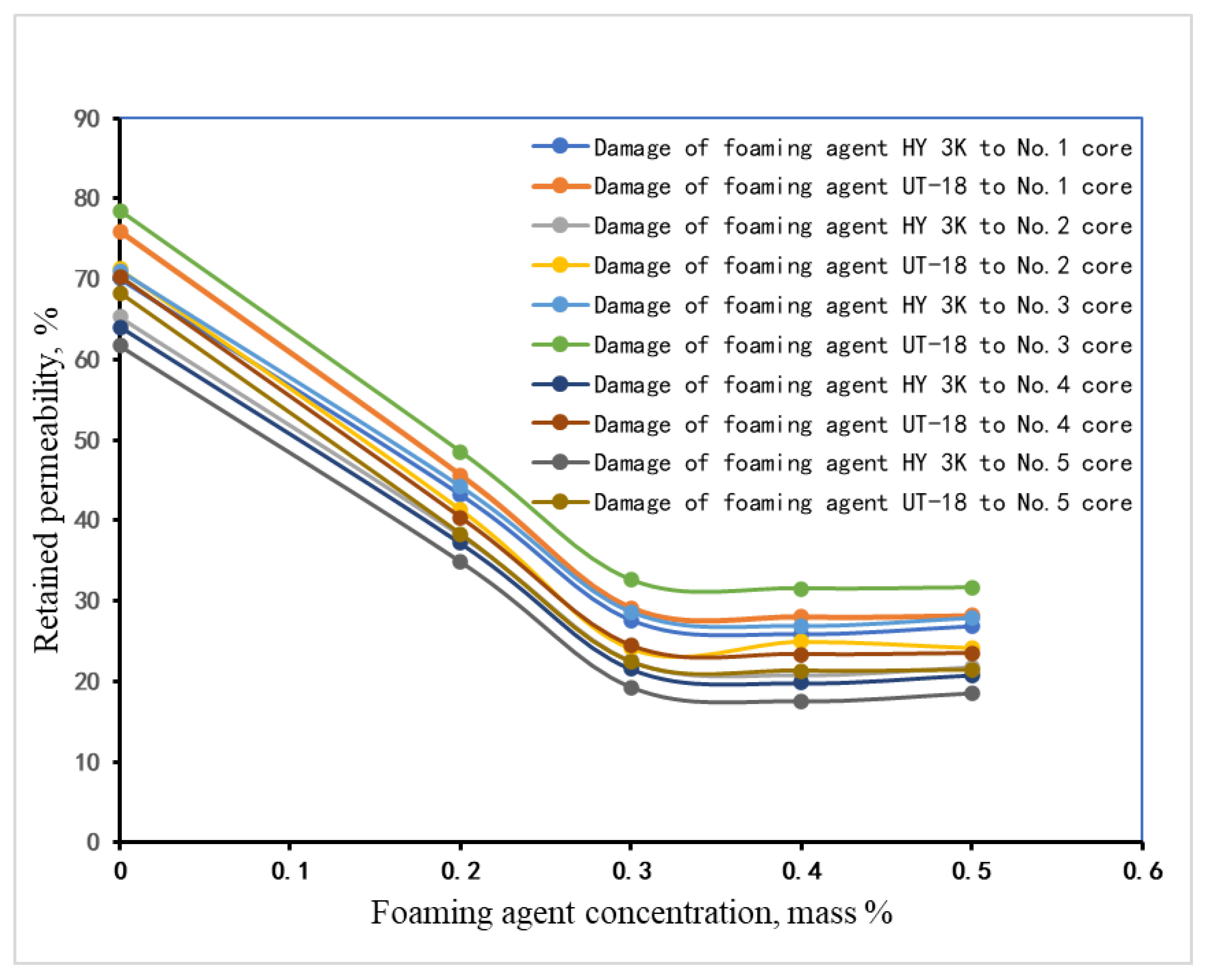
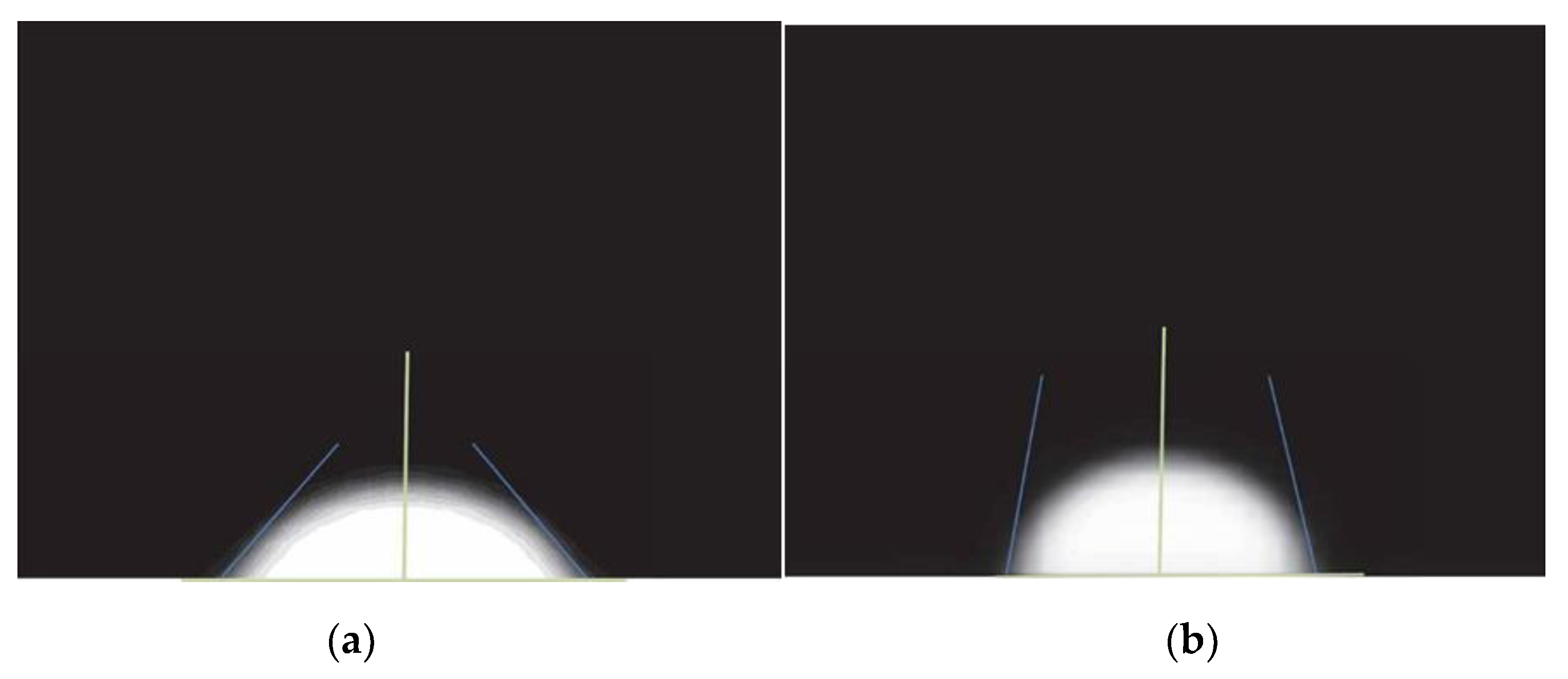
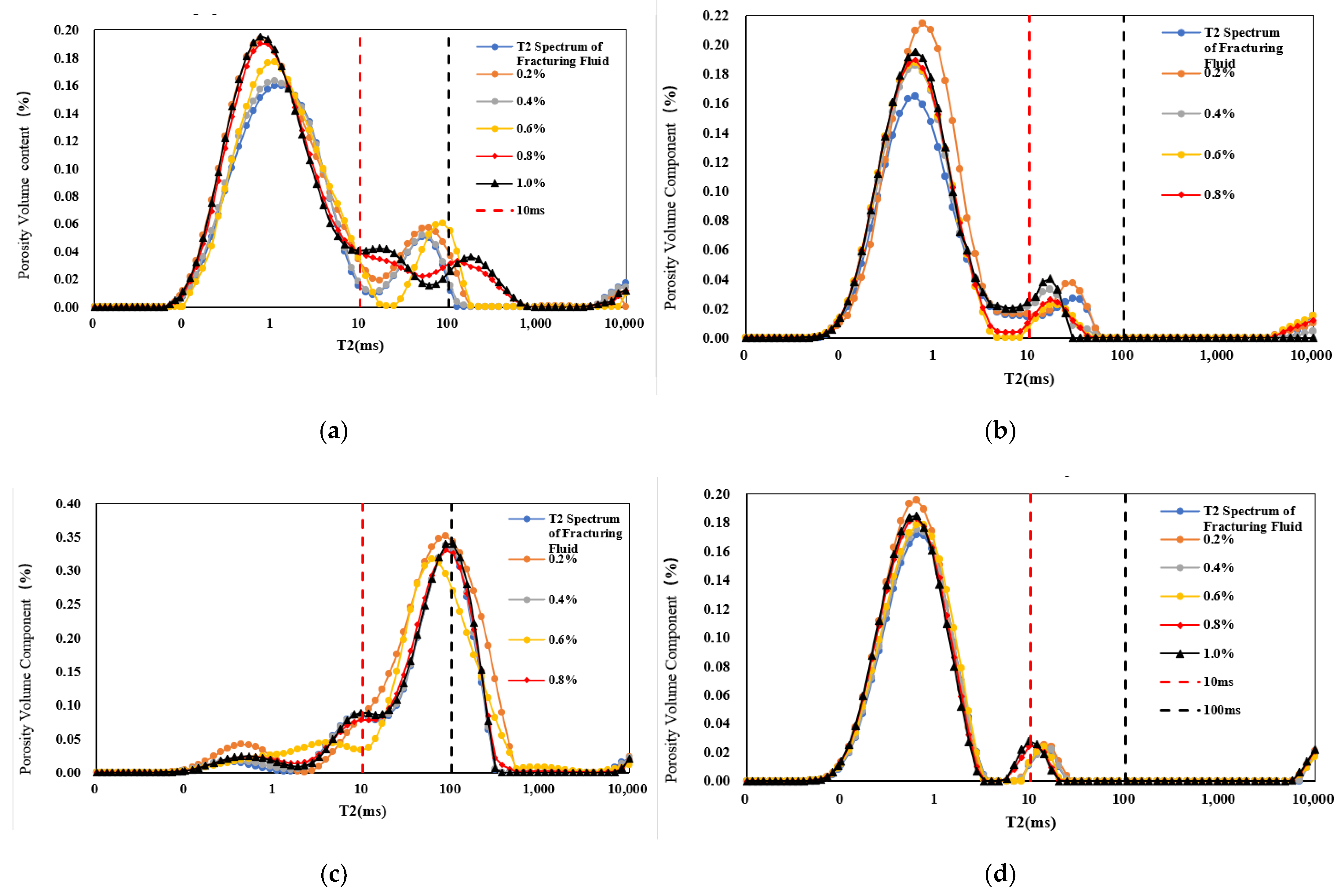

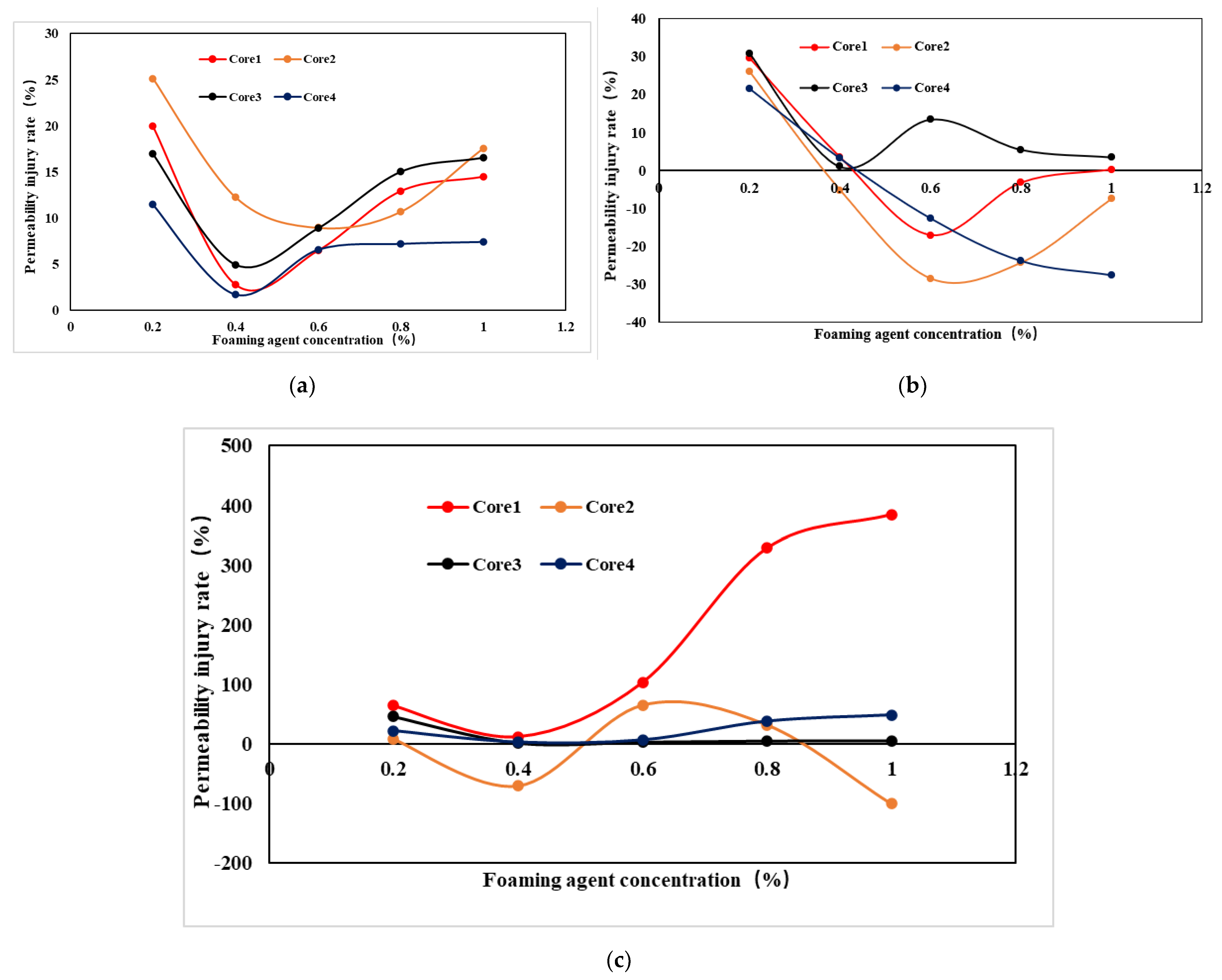
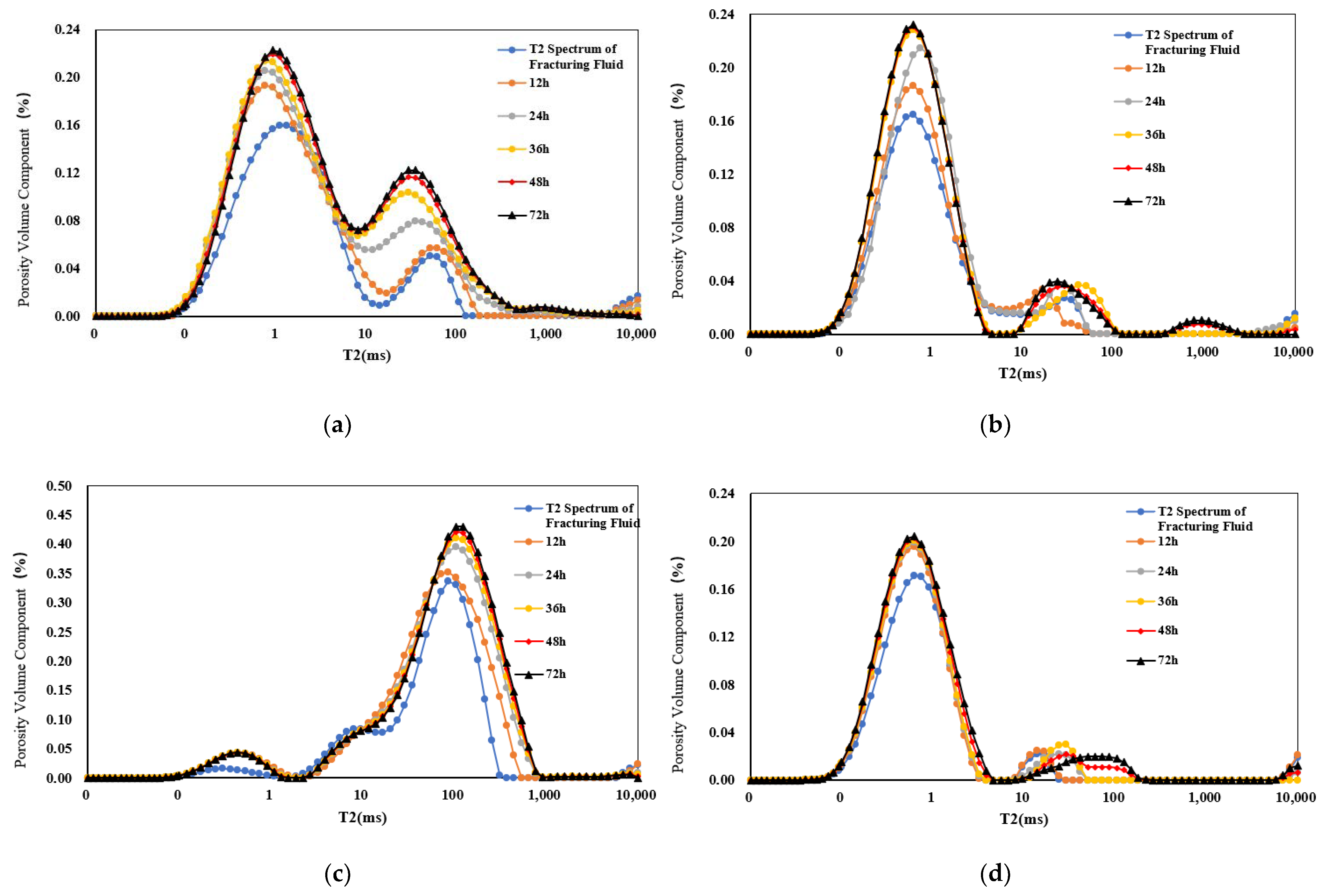
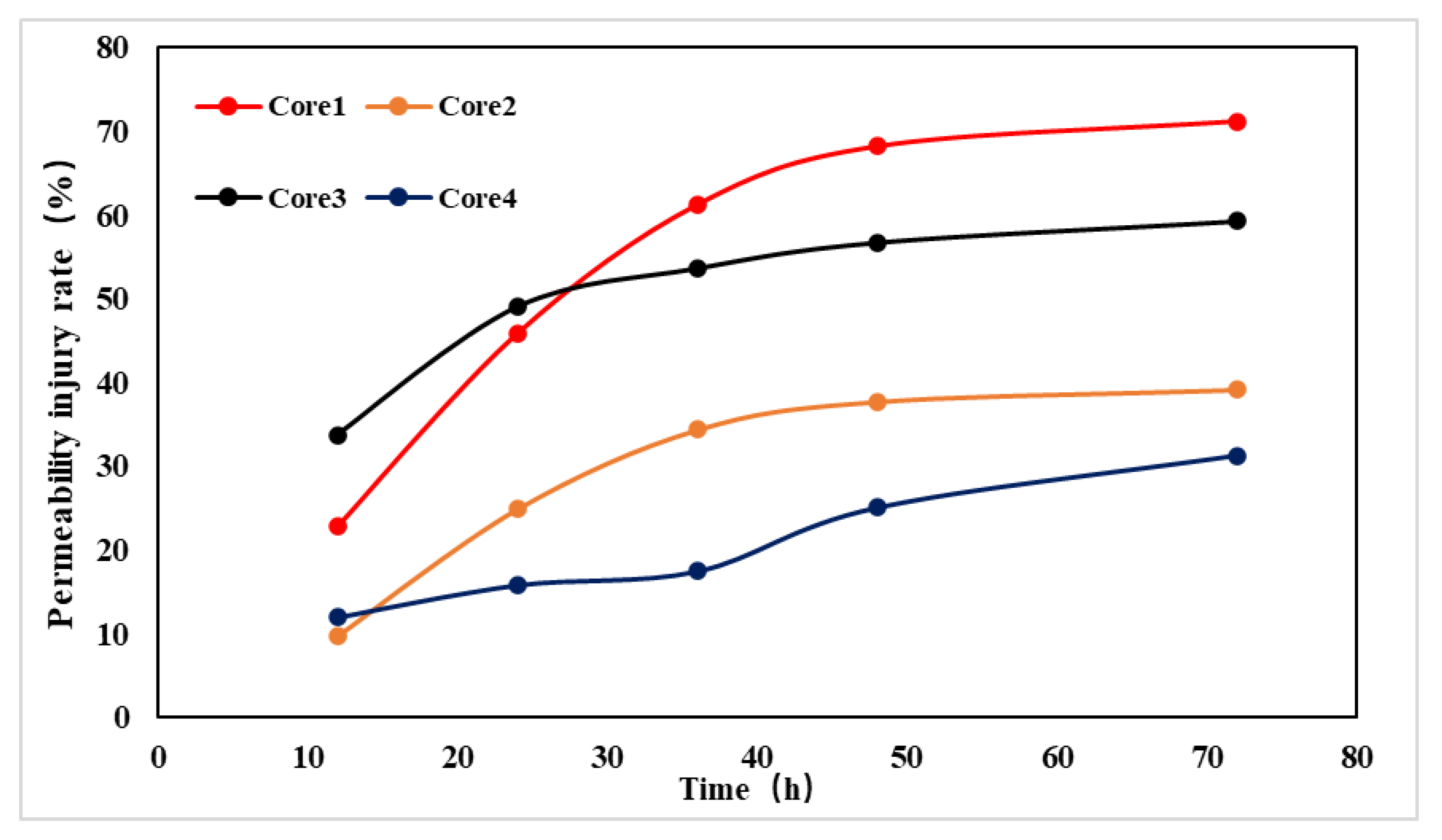
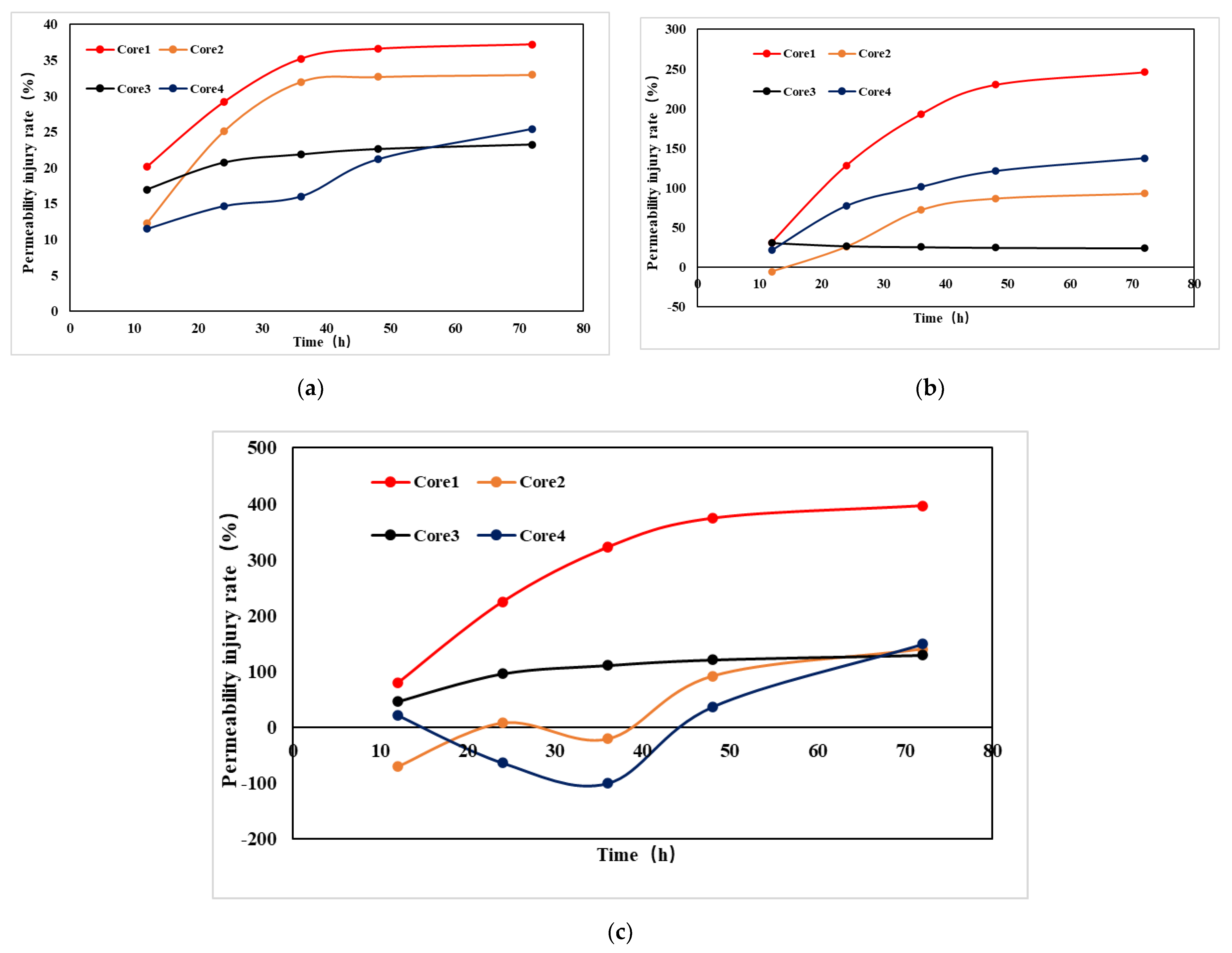
| Core | Depth | Quartz/Mass% | Potassium Feldspar/Mass% | Plagioclase/Mass% | Calcite/Mass% | Dolomite/Mass% | Pyrite/Mass% | Clay Mineral/Mass% |
|---|---|---|---|---|---|---|---|---|
| Core sample 1 | 727 m | 20.1 | 2.4 | 5.5 | 10.2 | 17.5 | 3.7 | 40.6 |
| Core sample 2 | 729 m | 36.7 | 11.8 | 7.4 | 17.0 | 15.9 | 11.2 | |
| Core sample 3 | 731 m | 41.0 | 5.3 | 16.0 | 37.7 | |||
| Core sample 4 | 732 m | 34.8 | 11.2 | 3.6 | 17.0 | 2.4 | 31.0 | |
| Core sample 5 | 733 m | 50.3 | 4.6 | 13.8 | 5.0 | 7.1 | 2.6 | 16.6 |
| Core sample 6 | 734 m | 40.6 | 4.1 | 12.5 | 2.2 | 8.8 | 4.6 | 27.2 |
| Core sample 7 | 735 m | 27.8 | 9.8 | 10.9 | 5.3 | 46.2 | ||
| Core sample 8 | 736 m | 37.9 | 3.0 | 13.4 | 6.6 | 39.1 | ||
| Core sample 9 | 746 m | 22.2 | 3.9 | 8.9 | 9.7 | 4.6 | 4.2 | 46.5 |
| Core sample 10 | 748 m | 35.3 | 6.0 | 16.6 | 15.1 | 3.4 | 23.6 |
| Cores | Depth | BET Specific Surface/m2/g | BJH Total Pore Volume/mL/g | Average Hole Diameter/nm |
|---|---|---|---|---|
| Core sample 1 | 727 m | 4.1649 | 0.021169 | 17.6092 |
| Core sample 2 | 729 m | 2.7028 | 0.012983 | 17.3485 |
| Core sample 3 Core sample 4 | 731 m | 11.4310 | 0.027764 | 9.7878 |
| 6.8263 | 0.030032 | 15.2298 | ||
| Core sample 5 Core sample 6 | 732 m | 6.3211 | 0.024285 | 14.3835 |
| 4.3914 | 0.019982 | 15.8772 | ||
| Core sample 7 | 733 m | 7.6815 | 0.029040 | 13.4212 |
| Core sample 8 Core sample 9 | 734 m | 8.4609 | 0.021433 | 10.1659 |
| 5.2295 | 0.022778 | 15.4011 | ||
| Core sample 10 | 735 m | 4.0763 | 0.018618 | 15.3115 |
| Core sample 1 Core sample 2 | 736 m | 3.8855 | 0.015886 | 14.3734 |
| 5.2343 | 0.020566 | 14.2955 | ||
| Core sample 3 | 746 m | 1.8111 | 0.009460 | 18.8684 |
| Core sample 4 | 748 m | 4.7837 | 0.021600 | 15.9722 |
| 2.6987 | 0.012352 | 15.9204 |
| Core Number | Experimental Condition | Experimental Temperature/°C | Experimental Pressure/MPa | Stabilization Time/Min | Contact Angle (°) | Wettability Type |
|---|---|---|---|---|---|---|
| No. 15 | 25,000 mg/L 0.9% NaCl | 60.0 | 18.0 | 10.0 | 6.57 | hydrophilic |
| No. 16 | 60.0 | 18.0 | 10.0 | 36.12 | hydrophilic |
| Name of the Agent | HY-3K | UT-18 | |
|---|---|---|---|
| Item | |||
| Appearance | Light yellow liquid | yellow liquid | |
| Density | 1.07 | 1.05 | |
| Foaming agent concentration | 0.4% | 0.4% | |
| Water surface tension at surfactant concentration of 0.4% (mN/m) | 21.7~26.6 | 29.5~31.2 | |
| Form half-life time (s) | 610 | 570 | |
| Foam composite index (mL·s) | 1,140,700 | 1,159,510 | |
| Liquid carrying capacity (mL/min) | 9.12 | 9.00 | |
| The effect on that stability of CO2 foam discharge agent | No significant impact | No significant impact | |
| Core Number | Surfactant% | Initial Permeability to N2/μD | Permeability Reduction after Solution Displacement by Surfactant,% (HY-3K) | Permeability Reduction after Solution Displacement by Surfactant,% (UT-18) |
|---|---|---|---|---|
| 1 | 0.0 | 23.4 | 70.02 | 75.81 |
| 0.2 | 17.6 | 43.16 | 45.58 | |
| 0.3 | 23.0 | 27.56 | 29.13 | |
| 0.4 | 37.6 | 25.82 | 28.02 | |
| 0.5 | 29.2 | 26.80 | 28.15 | |
| 2 | 0.0 | 15.4 | 65.30 | 71.25 |
| 0.2 | 16.6 | 38.16 | 41.32 | |
| 0.3 | 21.2 | 22.56 | 24.05 | |
| 0.4 | 19.6 | 20.82 | 24.91 | |
| 0.5 | 17.5 | 21.80 | 24.12 | |
| 3 | 0.0 | 13.7 | 71 | 78.50 |
| 0.2 | 15.6 | 44.16 | 48.51 | |
| 0.3 | 21.1 | 28.56 | 32.61 | |
| 0.4 | 14.6 | 26.82 | 31.53 | |
| 0.5 | 13.2 | 27.80 | 31.64 | |
| 4 | 0.0 | 13.4 | 64.03 | 70.32 |
| 0.2 | 15.1 | 37.16 | 40.35 | |
| 0.3 | 13.0 | 21.56 | 24.44 | |
| 0.4 | 14.8 | 19.82 | 23.36 | |
| 0.5 | 12.3 | 20.80 | 23.48 | |
| 5 | 0.0 | 23.4 | 61.70 | 68.30 |
| 0.2 | 17.6 | 34.86 | 38.30 | |
| 0.3 | 23.0 | 19.27 | 22.40 | |
| 0.4 | 37.6 | 17.53 | 21.30 | |
| 0.5 | 29.2 | 18.51 | 21.40 |
Publisher’s Note: MDPI stays neutral with regard to jurisdictional claims in published maps and institutional affiliations. |
© 2022 by the authors. Licensee MDPI, Basel, Switzerland. This article is an open access article distributed under the terms and conditions of the Creative Commons Attribution (CC BY) license (https://creativecommons.org/licenses/by/4.0/).
Share and Cite
Dou, L.; Chen, J.; Li, N.; Bai, J.; Fang, Y.; Wang, R.; Zhao, K. Quantitative Evaluation of Imbibition Damage Characteristics of Foaming Agent Solutions in Shale Reservoir. Energies 2022, 15, 5768. https://doi.org/10.3390/en15165768
Dou L, Chen J, Li N, Bai J, Fang Y, Wang R, Zhao K. Quantitative Evaluation of Imbibition Damage Characteristics of Foaming Agent Solutions in Shale Reservoir. Energies. 2022; 15(16):5768. https://doi.org/10.3390/en15165768
Chicago/Turabian StyleDou, Liangbin, Jingyang Chen, Nan Li, Jing Bai, Yong Fang, Rui Wang, and Kai Zhao. 2022. "Quantitative Evaluation of Imbibition Damage Characteristics of Foaming Agent Solutions in Shale Reservoir" Energies 15, no. 16: 5768. https://doi.org/10.3390/en15165768





